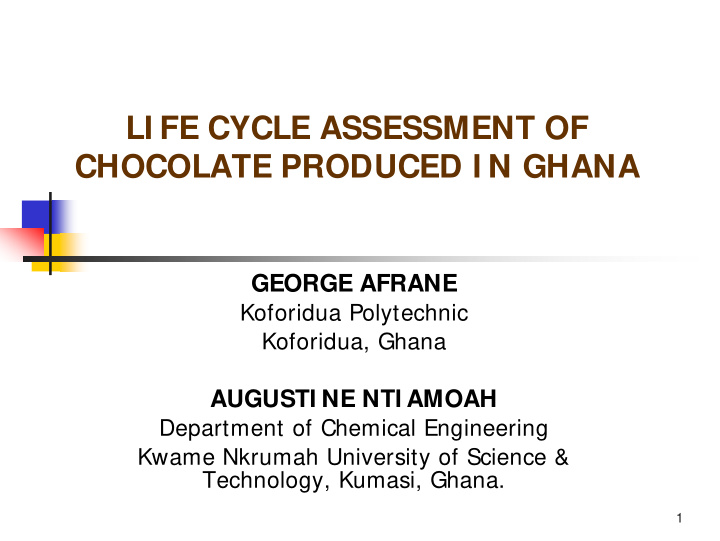



LI FE CYCLE ASSESSMENT OF CHOCOLATE PRODUCED I N GHANA GEORGE AFRANE Koforidua Polytechnic Koforidua, Ghana AUGUSTI NE NTI AMOAH Department of Chemical Engineering Kwame Nkrumah University of Science & Technology, Kumasi, Ghana. 1
Presentation Outline � I ntroduction � Life Cycle Assessment Methodology � Life Cycle I mpact Assessment Results � Conclusion and Recommendations � Acknowledgements 2
I ntroduction: About Ghana • GHANA land area: 94,000 sq. km • Population: 22 million • Cocoa contributes 12% to national GDP • Population associated with cocoa business: 6 million • Percentage of total population: 27 • Earnings as % of foreign exchange: 45 3
Aim of study 1. Study aimed to introduce LCA to the Ghanaian cocoa industry 2. To specifically conduct LCA on chocolate, the main cocoa product. 4
I SO LCA Methodology Goal and Scope Definition (ISO 14040) Inventory Interpretation Analysis (ISO 14043) (ISO 14041) Impact Assessment (ISO 14042) 5 Source: ISO 14040
Goal and Scope of the LCA study Goal •To identify and quantify key environmental impacts along chocolate’s production chain. • To assess the relative contribution of each stage of production to the identified environmental impacts. • To suggest a number of improvement options based on the results obtained. Target Group • Ghana Cocoa Board (COCOBOD) • All stakeholders of Ghana’s Cocoa Industry Functional Unit 1 kg chocolate LCI A method CML 2001 method Life Cycle Stages Cocoa Production, Bean Transportation, Cocoa Processing, Studied Chocolate Manufacturing 6
LI FE CYCLE OF CHOCOLATE Cocoa Cultivation Fertilizer Harvesting, Fermentation production and Drying Jute bag Pesticides Bagging and Storage cultivation and production Manufacturing NB: Processes captured Transport of beans to Processing factory in dotted boxes are excluded from the study I ndustrial cleaning, roasting, breaking and winnowing, and grinding of cocoa beans Mixing of cocoa liquor, Milk Sugar cocoa butter, milk, sugar production production and other ingredients Conching and Refining Tempering and Moulding Production of Chocolate packaging packaging Distribution and Retail Consumption phase 7 Expired food & packaging disposal
Life Cycle I nventory Analysis � Data collection � Relating data to functional unit � Modeling data to give inventory table 8
Life Cycle I mpact Assessment (using LCA software) � Classification - assign inventory data to Impact categories � Characterization - calculate potential environmental impacts of inventory data by using their equivalency factors 9
Life Cycle I mpact Assessment Results Overall I mpact Score Unit Environmental I mpact Category Acidification Potential 9.7351E-03 kg SO 2 -Equiv 3- -Equiv Eutrophication Potential 9.1568E-04 kg PO 4 Freshwater Aquatic Ecotoxicity Pot. 5.0797E+ 00 kg DCB -Equiv Global Warming Potential 3.5602E-01 kg CO 2 -Equiv Human Toxicity Potential 4.4426E+ 00 kg DCB -Equiv Ozone Layer Depletion Potential 4.9805E-09 kg R11-Equiv Photochem. Ozone Creation Potential 9.3002E-04 kg C 2 H 4 -Equiv Terrestric Ecotoxicity Potential 6.3796E-03 kg DCB -Equiv 10
Overall environmental profile for the profile for the production of 1 kg chocolate in Ghana 6.00E+00 5.00E+00 4.00E+00 3.00E+00 2.00E+00 1.00E+00 0.00E+00 AP EP FAETP GWP HTP ODP POCP TETP 11
Contribution by Life Cycle Stages to the total I mpact Scores CML2001, Terrestric Ecotoxicity Potential (TETP inf.) [kg DCB-Equiv.] CML2001, Photochem. Ozone Creation Potential (POCP) [kg Ethene-Equiv.] CML2001, Ozone Layer Depletion Potential (ODP, steady state) [kg R11-Equiv.] CML2001, Human Toxicity Potential (HTP inf.) [kg DCB-Equiv.] CML2001, Global Warming Potential (GWP 100 years) [kg CO2-Equiv.] CML2001, Freshw ater Aquatic Ecotoxicity Pot. (FAETP inf.) [kg DCB-Equiv.] CML2001, Eutrophication Potential (EP) [kg Phosphate-Equiv.] CML2001, Acidification Potential (AP) [kg SO2-Equiv.] 100 95 90 85 80 75 70 65 60 55 50 45 40 35 30 25 20 15 10 5 0 Chocolate manufacturing Cocoa processing Cocoa production Transportation 12
Conclusions and Recommendations � Freshwater aquatic eco-toxicity, Human toxicity, and Global warming are most significant environmental impacts associated with product. � Cocoa production, followed by cocoa processing identified as the key life cycle stages. � Need to review government’s current pests and diseases management programme towards a more organic cocoa production. 13
Conclusions and Recommendations cont‘d � Need to improve on efficiency of energy use in energy-intensive equipments such as roasters and boilers at processing factory. � Future work should include other relevant environmental impacts such as loss of biodiversity, disposal impacts of cocoa pod husks at the farming stage. Must also include packaging and other phases of life cycle omitted in current study. 14
Acknowledgements UNEP/SETAC Life cycle Initiative for awarding the GaBi � LCA software used for the analysis Management of Cocoa Processing Company, Tema � Management of Cocoa Research Institute of Ghana, � Tafo 15
16 THANK YOU!
Recommend
More recommend